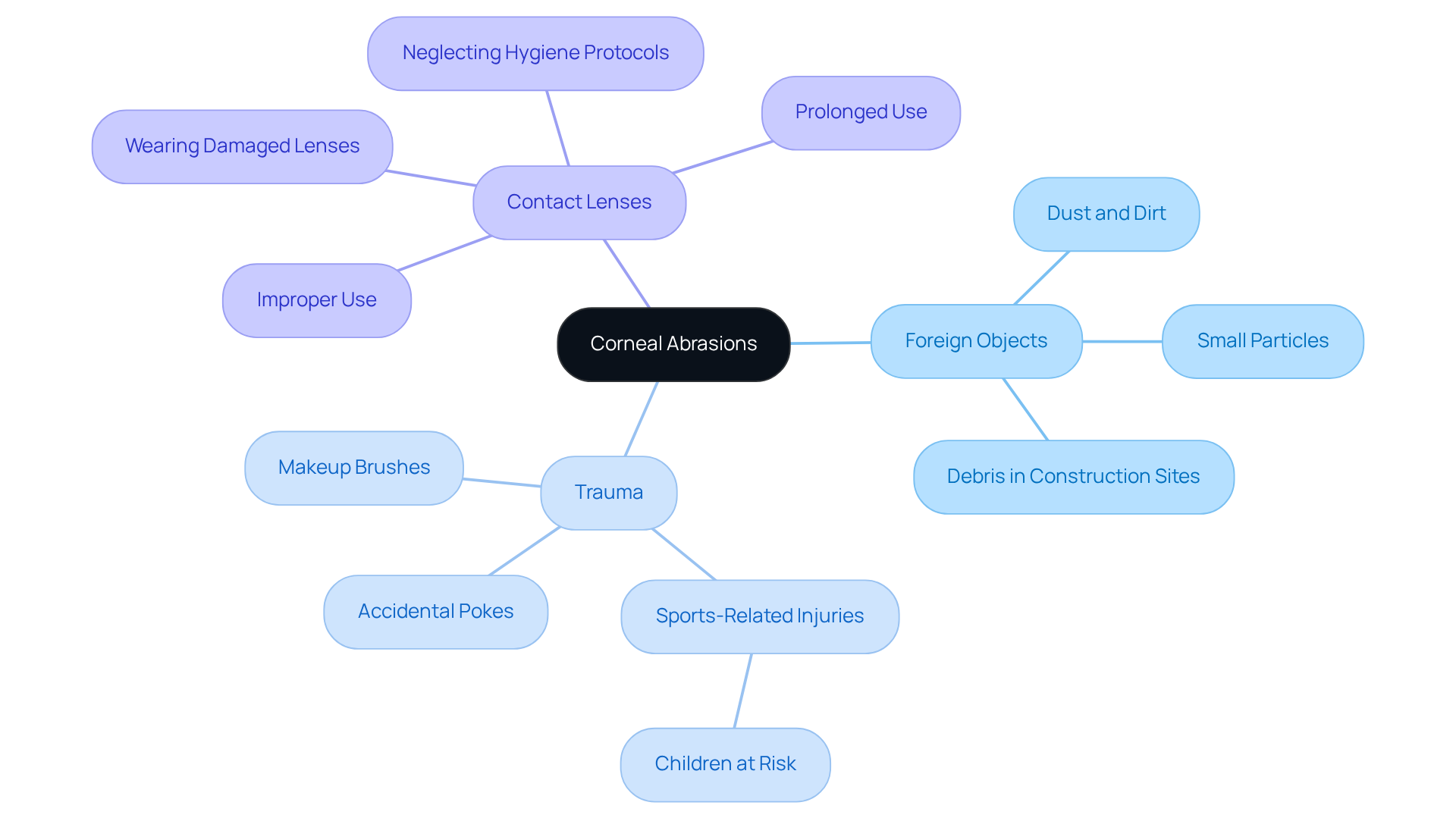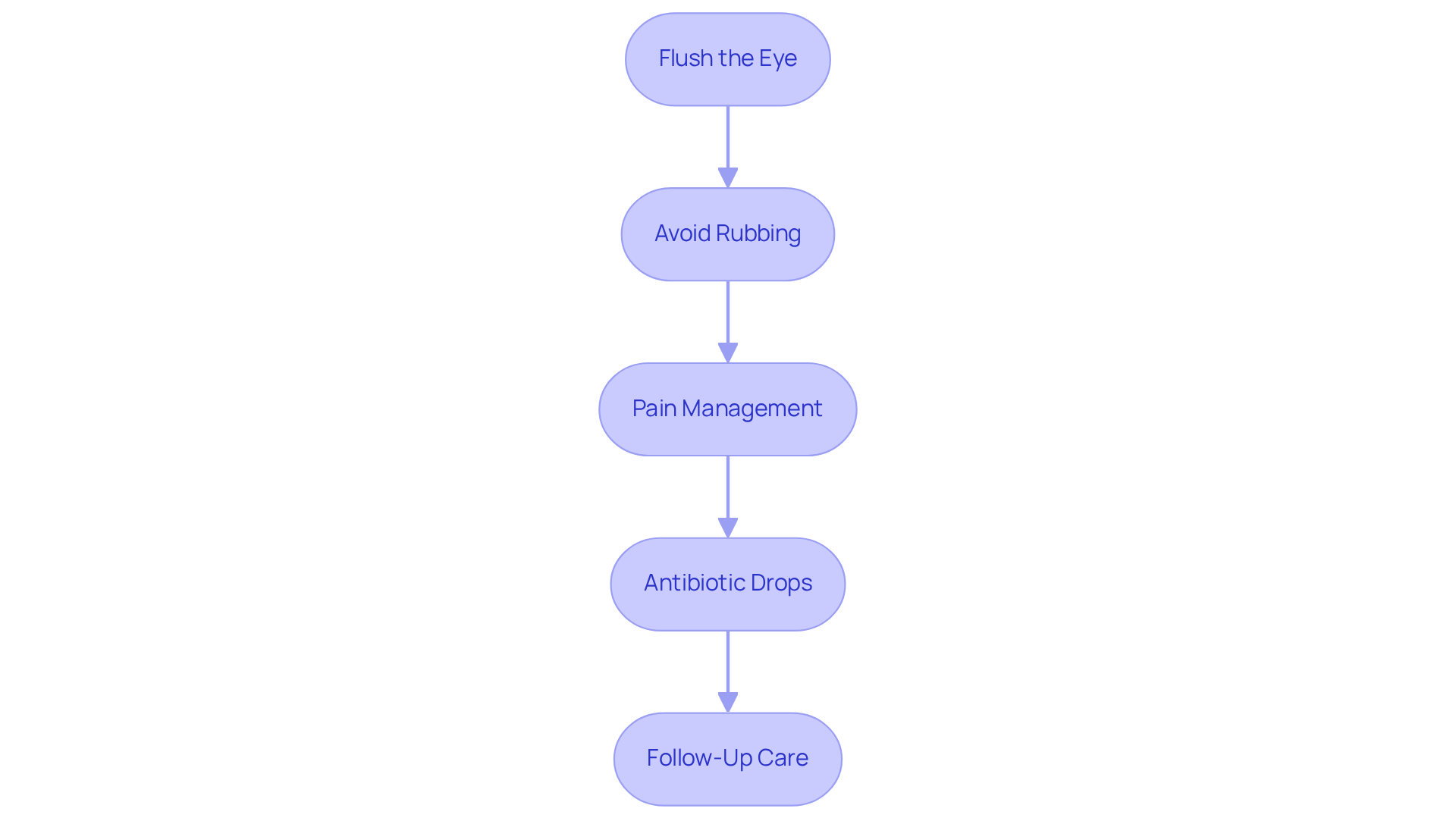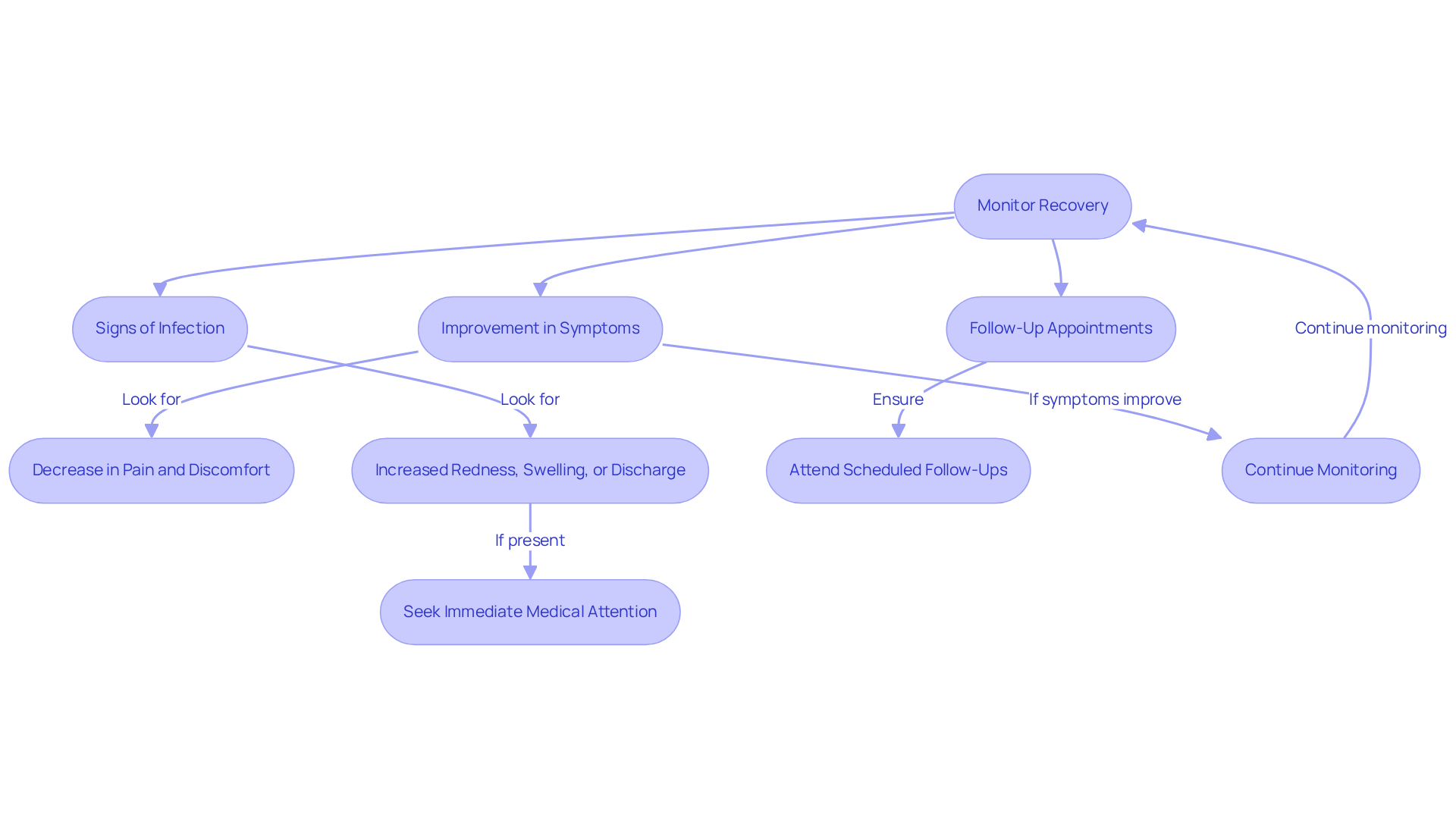Posted by: Northwest Eye in General on June 29, 2025
Overview
We understand that experiencing a corneal abrasion can be distressing, and it’s important to know that effective treatment is available. The article outlines four essential steps to help you through this process:
- Flushing the eye
- Avoiding rubbing
- Managing pain
- Applying antibiotic drops
Additionally, follow-up care plays a crucial role in your recovery.
Evidence supports that proper treatment and monitoring can significantly reduce discomfort and prevent complications. By following these steps, you can ensure a smoother recovery process. Remember, we are here to help you navigate your healing journey, providing the reassurance and support you need during this time.
Introduction
Understanding the intricacies of corneal abrasions is essential. These seemingly minor eye injuries account for a significant percentage of serious eye incidents requiring medical attention. We understand that it can be concerning to navigate such issues, but with the right knowledge, you can identify symptoms early and manage treatment effectively for a swift recovery.
However, knowing when to seek help and how to navigate the treatment process can be challenging. It’s common to feel uncertain about what steps to take to ensure proper healing and prevent complications from this common yet often overlooked injury. Remember, we are here to help you through this process.
Understand Corneal Abrasions: Definition and Causes
A scratch on at the front of the eye is defined as a scrape on the cornea. We understand that this can be concerning, especially since this condition is prevalent, accounting for approximately 8% of serious eye injuries that prompt individuals to seek medical attention. Corneal scratches are regarded as the most common eye injury. It’s important to know the common causes of corneal abrasions:
- Foreign objects: Dust, dirt, and small particles can easily scratch the cornea, particularly in environments with debris, such as construction sites or during sports activities.
- Trauma: Accidental pokes from fingers, branches, or makeup brushes are frequent culprits. In fact, many sports-related eye injuries stem from impacts, with children particularly at risk.
- Contact lenses: Improper use, such as wearing damaged lenses or neglecting hygiene protocols, can lead to injuries. Prolonged use of soft lenses heightens the risk of eye swelling and ensuing damage.
Most scratched corneas heal on their own within a few days, though corneal abrasion treatment can help expedite the healing. However, understanding these causes is crucial for preventing future injuries and recognizing when to seek corneal abrasion treatment. Eye specialists stress that upholding adequate eye protection, particularly in hazardous settings, can greatly decrease the chances of eye injuries. For instance, wearing protective eyewear during sports or in industrial settings is highly recommended to safeguard against potential eye injuries.
Dr. Arun Verma observes that eye surface injuries are frequently regarded as minor, yet more extensive involvement can result in issues like bacterial keratitis. We are here to help you through this process and encourage you to take proactive steps to protect your eyes.

Identify Symptoms of Corneal Abrasions
Signs of eye surface injuries can manifest in various forms, and we understand that identifying them quickly is essential for proper care. Common indicators include:
- Pain: You may experience a sharp or gritty sensation in the affected eye, which can be quite distressing.
- Redness: The eye might appear bloodshot, indicating irritation or inflammation.
- Light Sensitivity: It’s common to feel increased discomfort in bright environments, making it challenging to be in well-lit areas.
- Tearing: Excessive watering of the eye is a typical response as your body attempts to flush out the irritant.
- Blurred Vision: Difficulty focusing clearly can occur, impacting your daily activities. Blurred vision may also signal such as cataracts, diabetic retinopathy, dry eyes, or macular degeneration, which we commonly treat at Northwest Eye.
Studies show that a substantial proportion of individuals with eye injuries experience discomfort, highlighting the necessity for prompt medical attention. Most minor eye surface scratches usually recover within 1 to 3 days, whereas larger injuries may require corneal abrasion treatment and can lead to issues like infections or eye ulcers if not addressed quickly. Real-life patient experiences highlight that early recognition of these symptoms can lead to better outcomes, as prompt corneal abrasion treatment often alleviates discomfort and prevents complications. Consulting an ophthalmologist when these symptoms arise is essential for proper corneal abrasion treatment and recovery. As Dr. Nishika Reddy emphasizes, “If you have a significant wound or if you experience complications — such as an eye ulcer or infections — you can experience long-term vision loss.” If you are experiencing any of these symptoms, we encourage you to schedule an appointment with Northwest Eye for a professional evaluation. Additionally, resources like the Eye Condition Library and symptom checkers are available to empower you to understand your condition better.
Follow Treatment Steps for Corneal Abrasions
To effectively address your concerns regarding , we understand that you may have questions. Here are some steps to guide you through the process:
- Flush the Eye: Begin by gently rinsing the affected eye with saline solution or clean water. This helps eliminate any foreign particles that may worsen the injury.
- Avoid Rubbing: It’s common to feel the urge to rub your eye, but please refrain from doing so. Rubbing can aggravate the injury and hinder the healing process.
- Pain Management: Over-the-counter pain relievers or prescribed topical anesthetics can be helpful in alleviating discomfort. Effective pain management is essential; studies show that initial discomfort can significantly decrease within a few days with appropriate treatment. For instance, in a study, symptoms of initial discomfort decreased by 3.3 cm, 5.1 cm, and 6.5 cm after 1, 2, and 3 days in the non-patched group, respectively.
- Antibiotic Drops: Apply antibiotic eye drops as instructed by your eye care specialist. This is crucial in preventing infection, a common issue in eye injuries. Topical antibiotics are the most common immediate corneal abrasion treatment for corneal abrasions.
- Follow-Up Care: We encourage you to arrange a follow-up appointment to track your recovery and address any potential complications. Regular evaluations can ensure that your recovery progresses as anticipated. Studies indicate that cumulative incidences of restoration were 51%, 78%, and 92% after 1, 2, and 3 days in patched groups. Timely follow-ups contribute to better outcomes.
By following these steps, you can effectively manage your symptoms and encourage recovery, ensuring a smoother process. At Northwest Eye, we are here to help you through this process, emphasizing patient-centered care that provides personalized attention and expert medical guidance tailored to your specific needs.

Monitor Recovery and Seek Follow-Up Care
After treatment, we understand that monitoring your recovery is essential. Here are some key indicators to observe:
- Improvement in Symptoms: You should notice a gradual decrease in pain and discomfort, signaling that healing is progressing. Most straightforward eye surface injuries heal within 24 to 48 hours, providing comfort during your recovery.
- Signs of Infection: It’s important to be vigilant for any increased redness, swelling, or discharge from your eye, as these may indicate an infection. We emphasize that any signs of infection, such as persistent pain or worsening symptoms, require immediate medical attention to prevent long-term damage.
- Follow-Up Appointments: Please attend all scheduled follow-ups with your eye care provider to ensure your injury is healing properly. While most eye surface injuries recover within 24 to 48 hours, . Regular check-ups are crucial to prevent complications and ensure a full recovery. Complications can arise in approximately 10% of patients recovering from corneal abrasion treatment, highlighting the importance of diligent follow-up care.
By remaining proactive in your recovery, you can significantly improve your chances of a smooth recuperation process. Remember, avoiding rubbing your eyes is crucial, as this can delay healing. We are here to help you through this process.

Conclusion
Understanding corneal abrasions is essential for effective treatment and recovery. We recognize that these common eye injuries, often caused by foreign objects, trauma, or improper contact lens use, can lead to significant discomfort and complications if not addressed promptly. By acknowledging the symptoms and following the appropriate treatment steps, you can manage your condition effectively, ensuring a smoother healing process.
This article outlines crucial steps for treating corneal abrasions. These include:
- Flushing the eye
- Avoiding rubbing
- Managing pain
- Applying antibiotic drops
- Scheduling follow-up care
Each of these steps plays a vital role in facilitating recovery and preventing infections, which can lead to more serious eye issues. We understand that monitoring your recovery closely and seeking medical attention if symptoms worsen or do not improve is important.
Ultimately, prioritizing eye safety and being proactive about treatment can significantly impact your healing journey. Whether it’s through wearing protective eyewear or promptly addressing symptoms, taking these measures can help preserve your vision and enhance overall eye health. If you are experiencing signs of a corneal abrasion, seeking professional evaluation and adhering to treatment guidelines is crucial for a successful recovery. We are here to help you through this process.
Frequently Asked Questions
What is a corneal abrasion?
A corneal abrasion is a scratch on the clear, protective layer at the front of the eye, known as the cornea.
How common are corneal abrasions?
Corneal abrasions are the most common eye injury, accounting for approximately 8% of serious eye injuries that lead individuals to seek medical attention.
What are the common causes of corneal abrasions?
Common causes include foreign objects like dust and dirt, trauma from accidental pokes (e.g., fingers or branches), and improper use of contact lenses.
How do foreign objects cause corneal abrasions?
Foreign objects such as dust, dirt, and small particles can easily scratch the cornea, especially in environments with debris, like construction sites or during sports activities.
What role do contact lenses play in corneal abrasions?
Improper use of contact lenses, such as wearing damaged lenses or neglecting hygiene protocols, can lead to corneal injuries. Prolonged use of soft lenses increases the risk of eye swelling and damage.
How long does it take for a scratched cornea to heal?
Most scratched corneas heal on their own within a few days, although treatment can help expedite the healing process.
What preventive measures can be taken to avoid corneal abrasions?
Wearing protective eyewear in hazardous settings, such as during sports or in industrial environments, is highly recommended to reduce the risk of eye injuries.
What complications can arise from corneal abrasions?
While often regarded as minor, more extensive involvement from corneal abrasions can lead to issues like bacterial keratitis.
Who can help with corneal abrasion treatment?
Eye specialists can provide guidance and treatment for corneal abrasions and encourage proactive measures to protect your eyes.






